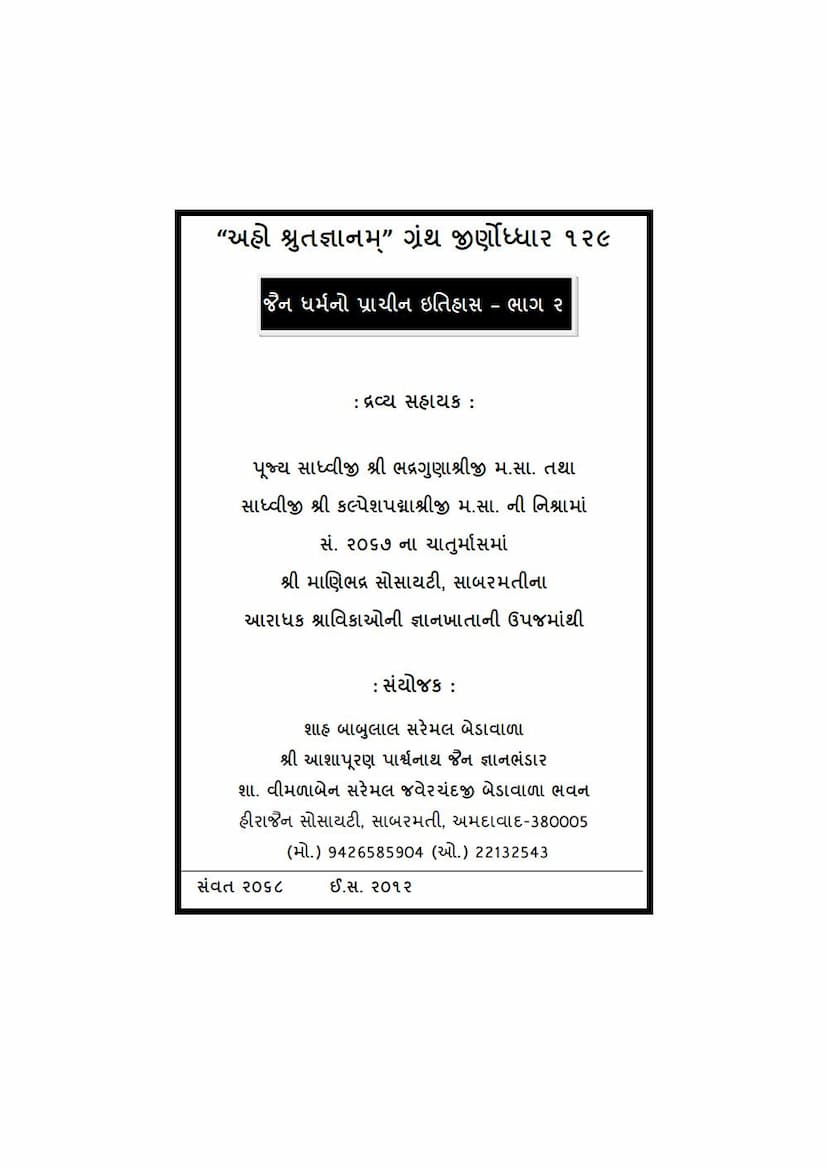Jain Dharm No Prachin Itihas Part 02
Added to library: September 2, 2025

Summary
This document, titled "Jain Dharm no Prachin Itihas Part 02" (Ancient History of Jainism Part 02) by Hiralal Hansraj and published by Shravak Hiralal Hansraj, is a comprehensive historical text that delves into the antiquity and evolution of Jainism. The catalog link provided, jainqq.org, suggests it's part of a larger digital library of Jain scriptures.
The text is structured into several chapters, exploring various facets of Jain history and philosophy:
Key Themes and Content:
- Antiquity of Jainism: A significant portion of the book is dedicated to establishing the ancient origins of Jainism, arguing that it predates Vedic traditions. It presents evidence by referencing ancient scholars like Shakatayanacharya and connecting Jain principles to early Vedic texts. The text highlights that Panini, a renowned ancient grammarian, cited Shakatayanacharya, who in turn is presented as an early Jain scholar.
- Origin of Jain Sects/Gachhas: The book provides a detailed account of the emergence of various Jain sects and sub-sects (Gachhas) within Jainism. It traces their origins, citing specific historical periods and the contributions of key figures who founded or influenced these lineages. Examples include the Digambara, Punmiya, Khartar, and Anchal Gachhas.
- Biographies of Key Figures and Historical Narratives: The text includes extensive biographical details and historical accounts of prominent Jain acharyas and influential figures. A significant portion is dedicated to the life and deeds of Hemchandracharya and his relationship with King Kumarpal of Gujarat. It narrates how Kumarpal converted to Jainism under Hemchandracharya's influence and the subsequent religious and administrative reforms undertaken during his reign.
- Jainism and Other Religions/Philosophies: The book engages in comparative analysis, discussing how Jainism relates to other prevalent religious and philosophical traditions of ancient India, including Hinduism (Vedic traditions) and Buddhism. It points out similarities and differences, often aiming to demonstrate Jainism's distinctiveness and antiquity.
- Evidence of Jainism's Antiquity: The text systematically presents various forms of evidence to support its claims about Jainism's ancient origins. This includes:
- Literary References: Citations from ancient Jain scriptures, as well as references to Jain figures and concepts found in non-Jain ancient Indian literature (e.g., Puranas, Mahabharata, Manu Smriti).
- Inscriptions and Archeological Findings: The book mentions the significance of ancient Jain inscriptions, particularly those found in Mathura and on pillars attributed to Emperor Ashoka. It attempts to analyze the language and content of these inscriptions to establish the presence of Jainism in very early periods.
- Chronological Data: A substantial part of the book is dedicated to a chronological listing of significant events, births, deaths, and the succession of acharyas and influential figures in Jainism, stretching back to the time of Rishabhanatha (the first Tirthankara) and continuing through the Mahavira era and beyond. This meticulous chronological record is crucial for substantiating historical claims.
- Ashoka and Jainism: A significant portion is dedicated to the historical figure of Emperor Ashoka. While acknowledging his association with Buddhism, the author strongly argues for Ashoka's early leanings towards Jainism. The text analyzes Ashoka's edicts and inscriptions, interpreting terms and commands as evidence of Jain influence and principles, particularly emphasizing his emphasis on non-violence (ahimsa) and compassion. The author critically examines Buddhist narratives about Ashoka, suggesting they might be biased attempts to claim him for Buddhism.
- Jain Scriptures and Doctrines: The book references and discusses various Jain scriptures, including Agamas, and delves into the concept of "Nigam Shastras" (which might be interpreted as Upanishads or philosophical treatises within Jainism). It lists numerous such texts, providing brief descriptions of their content.
- Specific Jain Practices and Beliefs: The text touches upon specific Jain practices and beliefs, such as the significance of the Tirthankaras, their lifespans, and the historical development of various monastic lineages (Gachhas).
- The Role of Hemchandracharya and Kumarpal: The book extensively details the influential period of King Kumarpal of Gujarat and his spiritual advisor Hemchandracharya. It covers Kumarpal's conversion, his patronage of Jainism, the construction of temples, and the impact of Hemchandracharya's teachings on the kingdom. This section is rich with historical anecdotes and accounts of religious reforms.
- Genealogies and Chronologies: The text provides extensive genealogical information of the Tirthankaras and their contemporaries, as well as a chronological listing of various Jain acharyas and the establishment of different Gachhas. This meticulous historical documentation is a hallmark of the work.
Overall Significance:
"Jain Dharm no Prachin Itihas Part 02" aims to provide a scholarly and evidence-based account of Jainism's history, emphasizing its deep roots in ancient Indian civilization and its foundational philosophical principles. It serves as a significant resource for understanding the historical trajectory, doctrinal development, and the lives of key figures within the Jain tradition. The detailed chronological lists and references to inscriptions underscore a commitment to historical accuracy and a desire to present a robust case for Jainism's antiquity.